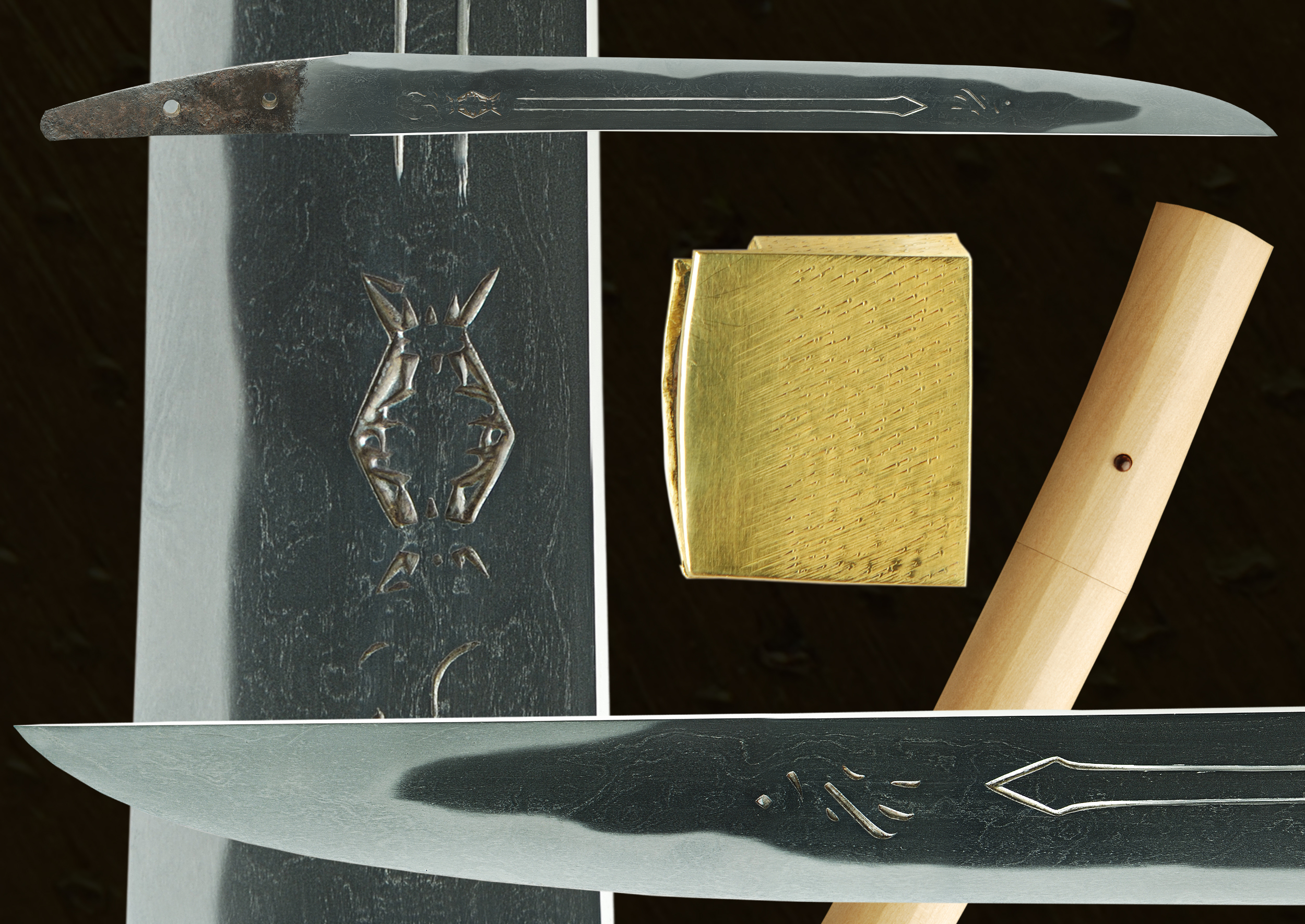This blade was judged as Shimada Sukemune.
Shimada sukemune was working from 1450 to
the late Muromachi period for several generations. This sword has a very nice Jigane and attractive Hamon,
This blade appears to be first generation Sukemune.
There is a fantastic jigane and a wavy gunome-midare hamon. This blade is Mitsu-mune with fine horimono of Bonji, Ken with Vajra and Gomabashi. There is a beautiful gold foil habaki and shirasaya. The blade comes with NTHK papers. This blade was papered by the NTHK prior to restoration.
History on the Shimada School:
The Shimada school in Suruga was along the Ōigawa river. The founder YOSHISUKE was active in the age of Kousho, the middle of 15th century and the other makers such as SUKEMUNE , HIROSUKE ,YOSHITSUNA MOTOSUKE appeared during the Muromachi period. The Suruga domain in those days had powerful regional warlords of the Imagawa , Takeda , Tokugawa who struggled with each other. The sword smiths of the Shimada school often had made a symbolic sign of swords or yaris to meet with the requirements from those powerful warlords.
SUKEMUNE , His family name Gojo and given name Kyuzaemon has been said to be a younger brother of the founder YOSHISUKE. It is believed that he moved from the province of Bizen to Shimada town in Suruga.
This tanto is attributed as the work of SUKEMUNE most likely during Tenbun-Eisho era (1532-69) who is highly renowned for the creation of the Osoraku-zukuri tanto which was owed by Takeda Shingen . It is unique with an extraordinary shape to show the impression that they were strongly influenced by the Soshu works of 14th C. Nanbokucho period. There are carvings of a ken with vajra and Gamabashi and Buddhist implements showing the close resemblance to Soshu works.
The Fish belly shape of the nakago was popular and frequently seen in Soshu works 、Suruga-Shimada 、Soshu-Tsunahiro and the Bushu-Shitahara schools all shared this feature at times showing that frequent cultural exchange became very active along Tōkaidō (region). There is an example of a collaboration Tanto work both by MURAMASA of the Sengo school in Ise and SUKEMUNE of the Shimada school in Suruga.The entire shape creates a majestic manner of heroic image by powerful warlords to pray fervently for success from the Buddha.
Sukemune was a highly regarded swordsmith from the Shimada School in the Soshu tradition that Masamune perfected in the 13th century in Kamakura.
He had a reputation for producing long tantos blessed with a thick kasane (spine) and fabulous jihada (body grain) comprising of itame and mokume (wood swirl patterns).
Sukemune was the creator of the O-soraku shape blade. An uncommon shape with a very large kissaki. It goes back to this smith Shimada Sukemune (島田助宗) who engraved the characters O-soraku onto the blade, thus the name O-soraku-zukuri. It is basically only seen on tantô and ko-wakizashi and was actively revived by the shinshintô-era Kiyomaro (清麿) school. The O-soraku-zukuri also became more fashionable in recent years and quite many shinsaku-to smiths get orders to make tantô in this shape.
- Mei: Mumei
- Date: Tenshō (天正, 1573-1592)
- Nagasa: 11-3/4 inches
- Sori: 0.0 mm
- Width at the ha-machi: 29.0 mm
- Thickness at the mune-machi: 7.2 mm
- Construction: Hira- zukuri
- Mune: Mitsu
- Nakago: Ubu
- Kitae: swirling itame
- Hamon: Midare Gunome
- Boshi: KO-Maru Kiri
- Condition: Good polish
Asking price: $4,000.00
Holiday Sale Price $2,800,00
(shipping and insurance included)
Email us if your interested in this item and remember to include the order number for this item: fss-781.
Click to Enlarge Image
Shintei-sho (審定書) – Appraisal
Den Shimada Sukemune (伝島田助宗)
shôshin (正真) – Authentic
Heisei 29 nen 8 gatsu 4 nichi (平成二十九年八月四日) – August 4, 2017
Nihon Tôken Hozon Kai (日本刀剣保存会) – NTHK
No 6410
meibun (銘文) – Signature: mumei
sunpō (寸法) – Measurements: 9 sun 9 bu (~ 30.0 cm)
tokuchō (特徴) – Characteristics:
kitae is itame,
hamon a gunome-midare,
bōshi is sugu with a ko-maru-kaeri,
the omote side features a bonji and a sanko-ken and the ura a bonji and gomabashi
bikô (備考) – Remarks: Suruga province, around Tenshō (天正, 1573-1592)
shinsa’in natsu’in (審査員捺印) – Seals of Judges: 4 seals
For Sale
























